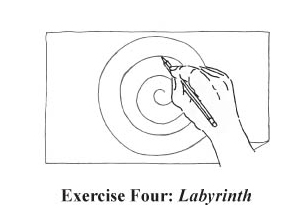
Parent & Teacher Resources
Labyrinth from the I Create What I Believe! Training Manual
This exercise has its roots in yogic breathing and labyrinth walking. It can relax the body, balance the brain, increase the sense of well-being, and develop the focusing capacity. It also develops hand-and-eye coordination. In this exercise the focus needs to be on the tip of the pencil, not on the design that is emerging. The pencil is only moved on the exhalations. The depth of their inhalation and the speed of their exhalation will decide how far their pencil can move with each breath. I recommend doing a little preliminary deep abdominal breathing before adding in the pencils and paper.
Preliminary Breathing:
Have participants place one hand on their belly and one hand on their chest. Then have them inhale in through their nose and bring the breath all the way down into their belly. (Their belly should move outward like a balloon filled with air.) When the belly is full, slowly squeeze the abdominal muscles to exhale the air. The hand on their belly should be moving in and out with their inhalation and exhalation. The hand on their chest should not move or move very little. Once they are clear on the way to breathe with this drawing exercise, you can have them pick up their pencils and do the exercise.
Instructions:
1. Place your pencil on the paper. Now take a deep breath. Remember to bring your breath all the way into your belly. When your belly is completely filled with air, slowly squeeze your abdominal muscles and exhale out your nose. Remember: it is your exhalation that is moving your pencil, so if you stop breathing your pencil should stop moving.
2. Inhale a second time bring the breath all the way to the belly. When the belly is full let the exhalation propel the pencil into an inward spiral. If the concentration is on letting the breath propel the pencil, it normally takes about three breathes to reach the center. Then guide them through three more breaths to spiral out from the center to the beginning.
3. In the outward spiral, they can either draw new lines or travel on previously drawn lines. Remember the power of the “entrainment factor” in this exercise. If you as the teacher are focused on bringing your breath deep in your abdomen and moving your pencil with your exhalations, you can actually pull any “timid” or resistant students into the exercise. Once they have had an experiential sense of this exercise and its benefits you won’t have to hold the energy so strongly. When I do the exercise I suggest a spiral pattern (either circular or straight lines that make right angles at the corner and each series of lines gets smaller and smaller).
“Discovery consists of seeing what everybody has seen and
thinking what nobody has thought.”
-Albert von Szent-Gyorgy© Nancy Marie. All Rights Reserved.
